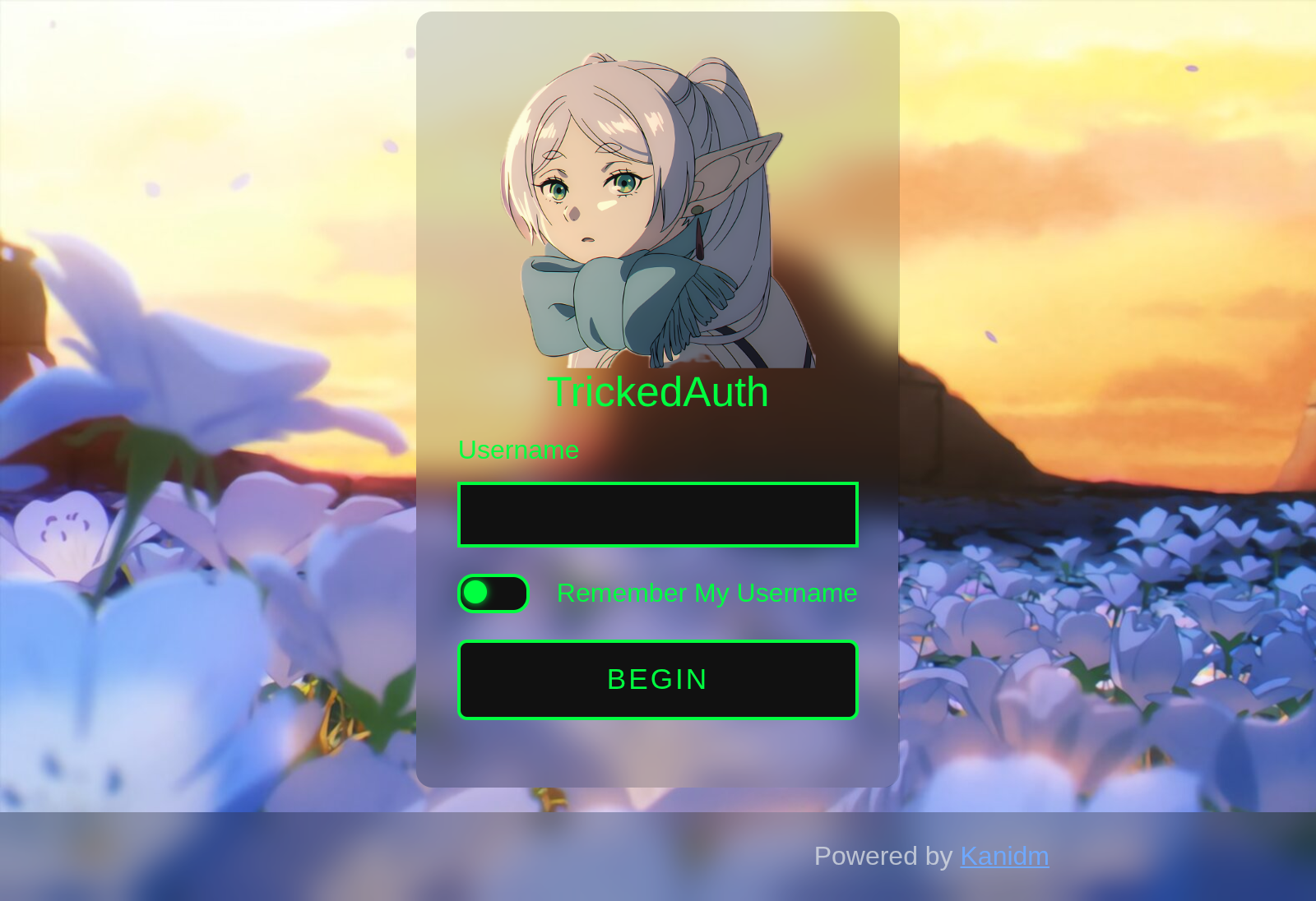
Customizing kanidm with css & images
Replacing images and css in the kanidm docker image by adding mountpoints
Prelude
Kanidm is great and has a decently nice looking ui with a ton of cool crabs, but sometimes you just want to customize a application to make it more personal and luckily Kanidm makes this quite easy.
most assets images/css are stored in the docker container and mostly loaded on request.
Changing the name
Starting with the name of the Kanidm instance this can be done with
kanidm system domain set-displayname Whatever this will change the Kanidm text
to what you provided see the banner image where i changed it to TrickedAuth
Changing the logo / Oauth2 logo/name
You can view the official guide and information to change these
Customizing built in logos and css
Extracting the docker images
Start by extracting the docker image
docker pull docker.io/kanidm/server:latestCID=$(docker create docker.io/kanidm/server:latest)docker cp "$CID":/ ./kanidm-rootfsdocker rm "$CID"after doing this you should copy just the kanidm-rootfs/hpkg folder to another
directory and delete the rest. Place the hpkg folder next to the
docker-compose.yaml of your Kanidm setup
and add the following mountpoints, my suggestion is to only mount the img and style folder so that updates wont cause issues down the line with changed js etc.
services: kanidm: image: docker.io/kanidm/server:latest ports: 8443:8443 volumes: - ./data:/data:rw,Z - ./hpkg/img:/hpkg/img:Z - ./hpkg/style.css:/hpkg/style.css:Z⏎hpkg overview:
.├── external│ <omitted>├── img│ ├── apple-touch-icon.png│ ├── favicon.png│ ├── icon-accounts.svg│ ├── icon-accounts.svg.br # You can safely delete all .br assets│ ├── icon-groups.svg│ ├── icon-groups.svg.br│ ├── icon-oauth2.svg│ ├── icon-oauth2.svg.br│ ├── icon-person.svg│ ├── icon-person.svg.br│ ├── icon-robot.svg│ ├── icon-robot.svg.br│ ├── icons│ │ ├── building-lock.svg│ │ ├── key.svg│ │ ├── person.svg│ │ ├── phone-flip.svg│ │ └── shield-lock.svg│ ├── kani-waving.svg│ ├── logo-{180,192,256,512}.png # these are only used for apple afaik you can skip overwriting these│ ├── logo-square.svg│ ├── logo-square.svg.br│ └── logo.svg├── modules│ └── cred_update.mjs├── pkhtml.js├── style.css # This file you want to edit to get custom styles└── style.jsAdding a background image
adding a image as background
body { // all assets in the hpkg folder are hosted in the `/pkg` path in Kanidm background-image: url(/pkg/img/bg.jpg); background-size: cover;}just append this to your style.css and put the desired background in de
hpkg/img folder i would recommend small jpg’s ~150kb so that the image is loaded
quickly instead of the default background being shown first
Updating existing images
you can then start editing the assets. One thing in the current version of
Kanidm most images are svg’s which have to stay svg - you can’t just rename a
png to .svg as the browser will still try to parse it as svg markup and fail. If
you want to put your own images instead of the svg’s you will likely want to use
other pngs/jpgs but you can’t just put <image> elements inside svg’s that
reference external URLs because kanidm’s content security policy doesn’t allow
external image references. This means you will have to use a script to embed the
photos directly into the svg as base64 data URIs with a script like this:
// Script generated by chatgpt basically just includes the <image> tags in a svg to base64 to make it so the image loadsconst fs = require("fs").promises;const path = require("path");const { JSDOM } = require("jsdom"); // Install with: npm install jsdom
async function embedSvgImages(inputSvgPath, outputSvgPath) { try { // 1. Read the input SVG file const svgContent = await fs.readFile(inputSvgPath, "utf8");71 collapsed lines
// 2. Parse the SVG content using JSDOM const dom = new JSDOM(svgContent, { contentType: "image/svg+xml" }); const document = dom.window.document;
// 3. Find all <image> elements const imageElements = document.querySelectorAll("image");
for (const imageElement of imageElements) { let href = imageElement.getAttribute("href");
// Check if href exists and is not already a data URI if (href && !href.startsWith("data:")) { // Resolve the absolute path of the image const imagePath = path.resolve( path.dirname(inputSvgPath), href, );
try { // Read the image file as a buffer const imageData = await fs.readFile(imagePath);
// Determine the MIME type const ext = path.extname(imagePath).toLowerCase(); let mimeType; switch (ext) { case ".png": mimeType = "image/png"; break; case ".jpg": case ".jpeg": mimeType = "image/jpeg"; break; case ".gif": mimeType = "image/gif"; break; case ".webp": mimeType = "image/webp"; break; case ".svg": mimeType = "image/svg+xml"; break; default: console.warn( `Warning: Unknown image type for ${href}. Skipping embedding.`, ); continue; // Skip this image if type is unknown }
// Convert image data to Base64 const base64Data = imageData.toString("base64");
// Create the data URI const dataUri = `data:${mimeType};base64,${base64Data}`;
// Update the href attribute imageElement.setAttribute("href", dataUri); console.log(`Embedded image: ${href}`); } catch (readError) { console.error( `Error reading image file ${imagePath}: ${readError.message}`, ); } } }
// 4. Get the modified SVG content const modifiedSvgContent = dom.serialize();
// 5. Write the modified SVG content to the output file await fs.writeFile(outputSvgPath, modifiedSvgContent, "utf8"); console.log( `Successfully embedded images and saved to ${outputSvgPath}`, ); } catch (error) { console.error(`Error processing SVG: ${error.message}`); process.exit(1); }}
// --- Command Line Argument Handling ---const args = process.argv.slice(2); // Get arguments excluding 'node' and 'script-name'
if (args.length !== 2) { console.log( "Usage: node embed-svg-images.js <input-svg-file> <output-svg-file>", ); console.log("Example: node embed-svg-images.js input.svg output.svg"); process.exit(1);}
const inputSvgFile = args[0];const outputSvgFile = args[1];
embedSvgImages(inputSvgFile, outputSvgFile);You can then create a simple script like this which will convert your svg’s to ones with base64
# or use node or deno whatever you prefer bun is the easiest though you wont need to npm i anythingbun embed-svg-images.js logo_src.svg logo.svgbun embed-svg-images.js logo-square_src.svg logo-square.svgYou can create files like this in the img folder of kanidm
.├── embed-svg-images.js├── convert.sh├── logo_src.svg├── logo.svg├── logo-square_src.svg├── logo-square.svg<svg width="64" height="64" xmlns="http://www.w3.org/2000/svg"> <image href="./confused.png" x="0" y="0" width="64" height="64" preserveAspectRatio="xMidYMid meet" /></svg>then the script will turn that into a svg like this
<svg width="64" height="64" xmlns="http://www.w3.org/2000/svg"> <image href="data:image/png;base64,ggg==" x="0" y="0" width="64" height="64" preserveAspectRatio="xMidYMid meet"/></svg>